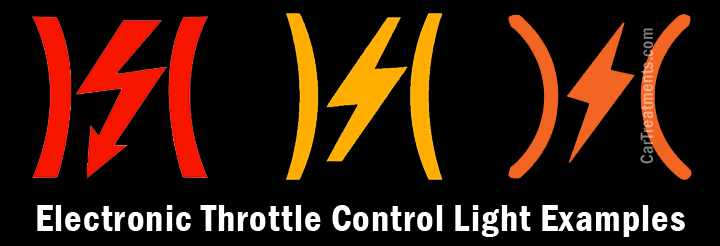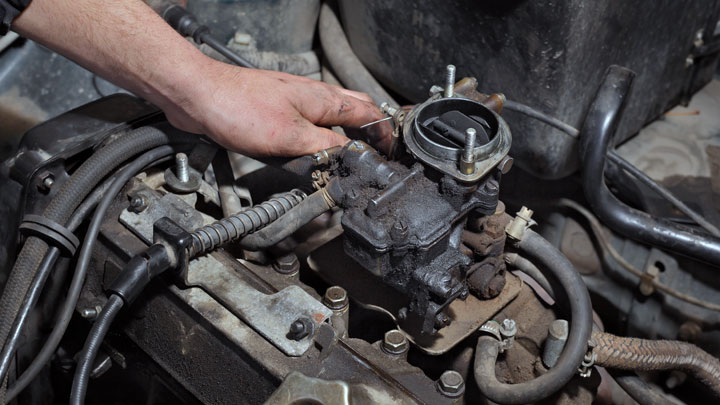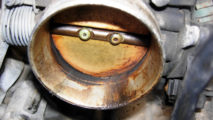Last Updated on November 29, 2021
During the development of the automobile, several different methods to control engine speed were utilized. Hand throttles were initially popular, but this method faded over time.
Eventually the engine speed and car speed control became the work of the driver’s right foot. Thus the accelerator pedal (or gas pedal) emerged. It was connected to the engine carburetor by a simple linkage or cable.
Pressing this pedal opened the air flow butterfly valve inside the carburetor causing engine speed to increase. This control system proved to be remarkably reliable and persisted pretty much unchanged through the late 1980s.
In the modern automobile (model year 1990 or newer) your right foot does the same job but engine speed is modulated by a completely computerized system. This system is called electronic throttle control (ETC).
This article will discuss this system including the throttle control warning light (TCL) that can alert you to fuel control problems before these problems bring your pleasant ride to a halt.
What is Electronic Throttle Control?

Electronic throttle control is a system integrated with your car’s master computer, the engine control unit (ECU). It utilizes a control module operated by the accelerator pedal and an electronic throttle body (air control valve – ACV) on the engine.
The electronic fuel injection (EFI) system is also controlled by the ETC. All three devices and systems work together enabling precise engine speed modulation.
When you press the gas pedal down, the ETC system opens the ACV’s internal butterfly valve to admit greater airflow to the engine while the EFI increases fuel flow. Thus the engine speeds up.
At the same time, the ECU adjusts the timing of both the engine valves and ignition in accord with programmed profiles that will produce smooth and powerful engine acceleration.
It should also be noted that the ETC dictates engine speed independent of gas pedal position during the warmup period just after you start the engine. Engine idle speed is automatically elevated to provide smooth cold operation as well as minimize unburned fuel from exiting the engine to the catalytic converters. In this fashion, emissions are minimized during cold start conditions.
Most air control valves include a throttle position sensor (TPS). The TPS provides a signal back to the ECU confirming that the air valve is responding precisely as it is commanded by the ECU.
In sports or high performance cars, the ETC may be designed to include several operational modes that can be selected by the driver. These modes might look like this:
- A so called ‘normal’ mode will serve most driving situations and offer the best fuel economy.
- A ‘sport’ mode could alter the ETC throttle position profile giving faster throttle response during acceleration.
- The next step might be a ‘track’ mode. This would be intended to further enhance performance.
These alternate modes would also include changes to valve and ignition timing profiles. Of course, selecting a performance setting will decrease fuel economy but will not adversely affect emissions. This multi-mode capability can add to the driving enjoyment for most automotive enthusiasts.
As clever as it may be, the ETC can malfunction. This is when the throttle control warning light (TCL) comes into play.
Related: 6 Symptoms of a Dirty Throttle Body
What is a Throttle Control Warning Light?
The throttle control warning light is located in your car’s instrument panel. This light will illuminate when degraded performance of the electronic throttle control is detected.
Like the check engine light (CEL), traction control light, or other warning lights, this light tells you a problem exists that may require corrective action. See your car’s owner’s manual for further information.
When you see the TCL steadily glowing or flashing, the Onboard Diagnostic System (OBD2) will have set one or more trouble codes. Using a diagnostic tool, you or your service technician can display these codes and use them to find the fault(s) with your car’s fuel-air supply and related systems.
See Also: Code P0122, Code P2135, Code P2138
What Does the Electronic Throttle Control Light Look Like?

The TCL icon in your instrument panel looks like this: a short vertical lightning bolt suspended between two curved inward vertical lines. Generally it will be yellow, red, or orange in color.
This light will momentarily illuminate during your car’s engine start procedure to let you know it is operating.
If it does, the owner’s manual will also show you the location and appearance of this light. Late model Dodge, Chrysler and Jeep products include this feature.
What Will Cause the TCL to Illuminate?
The following malfunctions will turn on the throttle control light:
#1 – ETC System Electrical Problems
Loss of or intermittent signal to or from the ECU or gas pedal module. i. Possible causes:
Faulty wiring or loose/corroded connectors
Faulty pedal module
Mechanical failure of module linkage to gas pedal
#2 – ACV Butterfly Valve Motion Inhibited
Valve unable to move smoothly from idle position to wide open position i. Possible causes
Dirt or corrosion around butterfly valve and/or shaft
Butterfly valve mechanical failure
Water entry to ACV causing internal corrosion or servo failure
#3 – Sensor Malfunction
Some type of fault or malfunction in a sensor such as the throttle position sensor (located on the air control valve) can cause the electronic throttle control light to come on.
Symptoms of an Electronic Throttle Control Problem

Engine operation can be adversely affected by any of the above malfunctions. Adverse operation may include any of the following disconcerting behaviors:
- Engine stalling
- Engine misfiring
- Rough or lumpy idling
- Inability to smoothly accelerate
- Inability to maintain a constant speed
- Reduced cruising speed
- The car will reach a certain speed but go no faster.
- This may occur if the ECU determines higher speeds will damage the engine or related systems. This is referred to as limp mode.
- Engine will either not start or be difficult to start
- Noticeable reduction in fuel economy
- Black smoky exhaust
As mentioned above, any problems that cause the TCL to come on will set a fault code. The check engine light (CEL) will also illuminate.
ETC problems can mimic other engine system issues. This is where OBD2 fault codes can prove to be exceptionally beneficial in enabling proper diagnostic work.
Can You Drive With the TCL Illuminated?
A steadily lit throttle control light indicates an intermittent or ongoing problem, but the car may still be driven. It is possible that the ECU will limit top speed as discussed above. The TCL ‘on’ condition should be addressed as soon as possible to avoid cumulative damage to other systems in your car.
A flashing throttle control light (like a flashing CEL) indicates a serious problem that will require immediate service. Beyond reaching a safe place off the side of the road, the car should not be further driven when either of these warnings are noted.
This will admit excess unburned fuel to the catalytic converter(s) in the exhaust system causing localized extreme temperatures.
Overheating of the converter(s) may result in damaging or internally destroying these costly devices. This is just one key reason why expeditiously heeding the warning posed by the illuminated TCL and/or CEL is always wise.





My etc warning light is on and check engine, the heat is Luke warm and temp gadge is on cold. This is a new motor and tranny
How long has it been since the motor was replaced? Perhaps you could take it back to that shop and have them check it over. I’m guessing it’s a sensor or ground issue with the throttle position sensor or accelerator pedal sensor.
in 2021 I had the Throttle Body replaced on my 2015 FIAT 500 after experiencing loss of power on the freeway and no acceleration. I had to take it back to the dealership to do the “relearn” and then it ran great until April of 2022, when the same problem (sort of) happened. ETC light and check engine light both came on including the hill start unavailable light and stabilization control light. So I took it to the FIAT dealership here and they said I needed a new throttle body. I know they could see that it had already been replaced once. Now at the end of May 2022, same issue, ETC light and check engine light, and limp mode, but this is with a NEW throttle MOPAR throttle body. What else is there to check? Is there a Throttle sensor? Could it be something with the pedal module? Code was P0122, P2135, P2138. Appreciate any help because the dealership where I have to have the work done (under warranty) isn’t the brightest. They just want to replace the throttle body that was just replaced 2 months ago.
That’s weird they keep trying to replace the throttle body, even though it’s not solving the problem. That sounds like an electrical issue to me, like a bad ground or a short in the wiring. I’ve had luck troubleshooting this type of problem by grabbing the factory service manual, figuring out which ground is used by the malfunctioning sensor, then tracing that back to a single ground point.
There’s a good chance that ground is dirty or corroded. I’ve even had this happen on a 4 year old car. In my case, when I figured out which ground I needed to check and opened up the connector, it was pretty easy to tell the ground was slightly corroded. Cleaning the ground solved an intermittent issue I had with my pedal assembly.
I would suggest to the dealership that they check the ground(s) used by the throttle position sensor. It’s probably a chassis ground in the engine bay.
While you are driving, suddenly this etc indicator is flashing, if cruising, no problem but if slow.down the engine will be vibrating that it will stop then when you stopped, the engine suddenly stopped but if you start it again, the engine is okay again and indicator is gone, and it happens again after certain kilometer